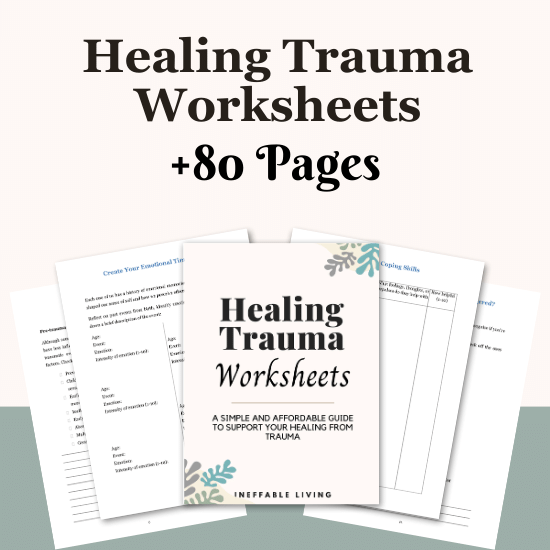In this post, you’re going to learn how to feel safe in your body.
What Causes You to Feel Unsafe In Your Body?
Feeling unsafe in one’s body can stem from a variety of factors, including past experiences, psychological processes, and environmental influences. Some common causes that contribute to feeling unsafe in your body may include:
1. Trauma: Past traumatic experiences, such as physical or emotional abuse, assault, or neglect, can profoundly impact feelings of safety within the body. The lingering effects of trauma can manifest as hypervigilance, disconnection from bodily sensations, and a pervasive sense of vulnerability.
2. Chronic Stress: Persistent stress or anxiety can heighten feelings of unease and discomfort within the body. Long-term exposure to stress hormones can contribute to a heightened state of arousal, leading to physical tension, restlessness, and a diminished sense of safety.
3. Body Image Concerns: Negative body image and societal pressures related to appearance can lead to feelings of insecurity, shame, and disconnection from one’s body. Internalizing unrealistic beauty standards or experiencing body shaming can erode a positive relationship with the body and contribute to feelings of unsafety.
4. Attachment and Relationship Dynamics: Early attachment experiences and relational patterns can influence one’s sense of bodily safety. Insecure attachment styles or experiences of invalidation within close relationships can impact the perception of safety within one’s body and in interpersonal interactions.
5. Cultural and Societal Influences: Cultural norms, social stigma, and discrimination based on race, gender, sexual orientation, or identity can contribute to feelings of unsafety within the body. Experiencing marginalization or discrimination can lead to heightened vigilance and a sense of threat within one’s own body.
6. Shame and Self-Criticism: Internalized shame, self-criticism, and negative self-talk can undermine feelings of safety and acceptance within the body. Harboring feelings of inadequacy or self-blame can create an internal environment of distress and discomfort.
7. Past Medical Trauma: Previous experiences of medical procedures, surgeries, or healthcare-related trauma can lead to mistrust of one’s body and healthcare providers, resulting in feelings of unsafety within the body.
Recognizing the multifaceted nature of these factors can guide efforts toward addressing and healing feelings of unsafety within the body.
Related: 7 Trauma Release Exercises To Support Your Recovery After Trauma
How to Feel Safe In Your Body?
1. Understand Trauma Responses
It’s important to recognize that feeling unsafe in your body can be linked to past trauma.
Understanding trauma responses, such as hypervigilance, dissociation, or heightened anxiety, can provide insight into the origins of feeling unsafe and guide efforts towards healing and self-compassion.
Hypervigilance: Hypervigilance refers to a heightened state of awareness and sensory sensitivity to potential threats in the environment. Individuals experiencing hypervigilance may be constantly on high alert, scanning their surroundings for any signs of danger.
Dissociation: Dissociation involves a disconnection or detachment from one’s thoughts, feelings, memories, or sense of identity. It can manifest as feeling disconnected from one’s body or surroundings, experiencing time distortion, or having gaps in memory. Dissociation often serves as a coping mechanism in response to overwhelming stress, trauma, or distressing experiences, allowing individuals to distance themselves from the full impact of the situation.
Heightened Anxiety: Heightened anxiety refers to an intense and persistent state of apprehension, nervousness, and worry that significantly impacts daily functioning. This heightened state of anxiety can manifest through physical symptoms such as rapid heartbeat, muscle tension, restlessness, and difficulty concentrating.
Related: Best 11 Grounding Techniques For Dissociation
2. Practice Grounding Techniques
Grounding techniques can help bring attention back to the present moment and foster a sense of safety within your body.
Practices such as deep breathing, progressive muscle relaxation, mindfulness meditation, and sensory awareness exercises can help anchor you in the present and alleviate feelings of distress.
The following are some grounding techniques you can practice:
5-4-3-2-1 Technique
This technique involves engaging the senses to bring attention to the present moment. Start by identifying and verbally acknowledging:
– 5 things you can see
– 4 things you can touch
– 3 things you can hear
– 2 things you can smell
– 1 thing you can taste
This exercise helps redirect focus away from distressing thoughts and sensations and toward immediate sensory experiences, promoting a sense of presence and calm.
Grounding Objects
Carrying or using grounding objects can serve as a tactile anchor to the present moment.
These objects can include smooth stones, textured fabrics, or other items that provide sensory stimulation.
When feeling overwhelmed or disconnected, focusing on the texture, weight, and temperature of the grounding object can help bring attention back to the immediate surroundings and provide a comforting point of reference.
Related: Best 10 Grounding Meditation Exercises
3. Practice Physical Self-Care
Engaging in regular physical self-care activities, such as exercise, yoga, or massage, can foster a positive connection with your body.
Tending to your body’s physical needs and engaging in activities that promote strength, flexibility, and relaxation can contribute to a sense of safety and well-being.
4. Explore Body Awareness
Cultivating body awareness involves paying attention to bodily sensations, emotions, and patterns of tension or discomfort.
Practices such as body scans, gentle stretching, and body-focused mindfulness can facilitate a deeper connection with your body and promote a sense of safety and acceptance.
Here’s how you can practice a simple body scan exercise:
- Begin by finding a comfortable position, either sitting in a chair with your feet flat on the floor or lying down on your back with your arms at your sides.
- Take a few deep breaths to center yourself and bring your attention to the present moment. Notice the sensations of each inhale and exhale, allowing your breath to become steady and relaxed.
- Shift your attention to your feet. Notice any sensations, such as tingling, warmth, or pressure. Without trying to change anything, simply observe the feelings in this part of your body.
- Slowly move your focus upward, from your feet to your ankles, calves, knees, thighs, and so on, systematically scanning and acknowledging the sensations in each part of your body.
- Continue the body scan all the way up to the top of your head, noticing any thoughts, emotions, or physical sensations that arise along the way.
5. Build a Supportive Environment
Surrounding yourself with supportive and understanding individuals can create an environment that fosters feelings of safety and validation.
Cultivating relationships characterized by empathy, trust, and respect can contribute to a sense of security within your body and in your interactions with others.
Related: Top 23 Grounding Affirmations
6. Establish Boundaries
Setting and maintaining healthy boundaries is crucial in fostering a sense of safety within your body and in your relationships.
Clearly communicating your needs, limits, and personal space can help establish a sense of safety and autonomy.

Conclusion
By incorporating these practices into your life and seeking support as needed, you can cultivate a greater sense of safety, acceptance, and connection within your body, ultimately contributing to a more harmonious relationship with yourself and the world around you.



